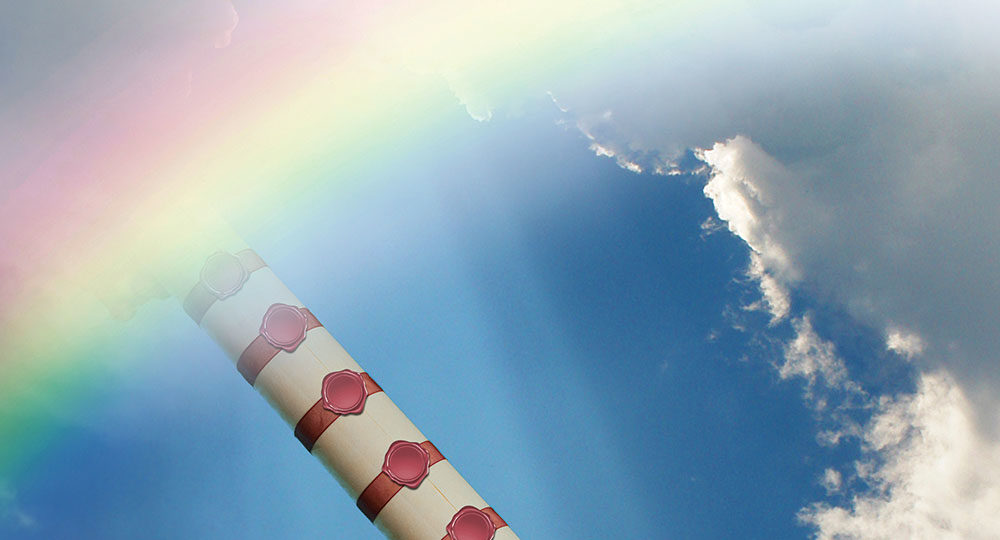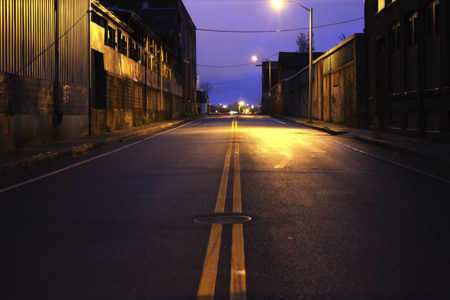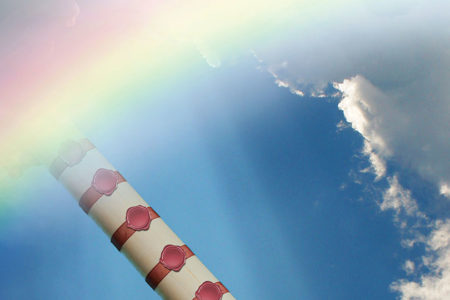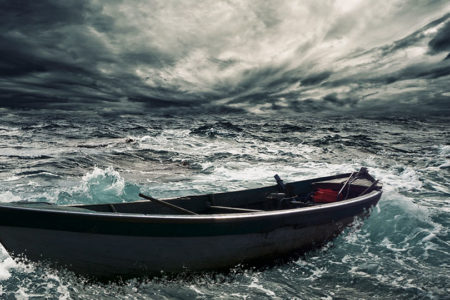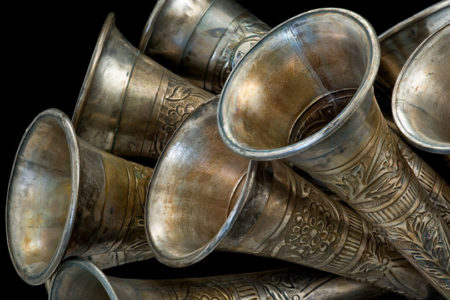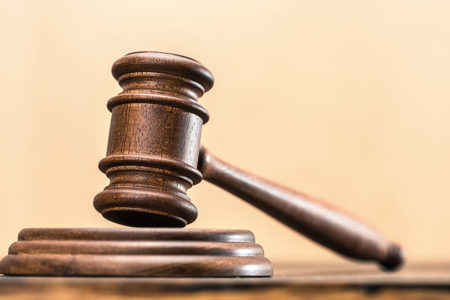The Beginning of the End
The scene is set, and Earth’s events are directed from heaven. Revelation 4 contains the apostle John’s recorded vision of heaven’s throne room where God’s plans for restoring His earthly Kingdom unfold. Continual praise is offered to the supremely holy God whose rights as Creator are about to be revealed.
The Sealed Scroll (Rev. 5:1–14)
The scene focuses on a scroll that no one is able to open, held in God’s right hand. It contains the written account of God’s program for regaining the sin-cursed earth and establishing His reign of peace and righteousness.
One person alone emerges as uniquely worthy to take the scroll and open its seals: “the Lion of the tribe of Judah, the Root of David” (v. 5). The reference is to Jesus the Messiah, the only One worthy to take the scroll of God’s master plan for Earth’s final destiny and open the seven seals that bind it. Jesus’ sacrificial death provided the basis for God’s final expression of judgment in human history as further described in the book of Revelation.
John set the stage and then focused on the scroll. His scene shows Christ breaking the seven wax seals that protect the message written on both sides—a message of judgment for sinners and blessing for God’s people. Each seal represents a different judgment. The first four seals are a unit and depict four horsemen riding throughout the entire earth, echoing Zechariah 1:8–10 and 6:1–8.
The remaining seals reveal broader scenes of God’s wrath, which places the world under judgment for seven years of devastation, ending life on Earth as we know it. Only after this event will Earth be prepared for the return of God’s Messiah, when believers “shall reign on the earth” (Rev. 5:10).
First Seal: Antichrist (Rev. 6:1–2)
The first rider comes on a white horse. Unlike Revelation 19:11, where the rider is Jesus Christ, the rider in this context is the Antichrist. His role as conqueror dovetails with the Old Testament description of the end-times king who conquers his rivals to establish his own ungodly authority (cf. Dan. 7:8, 20–25).
Second Seal: War (Rev. 6:3–4)
Worldwide warfare breaks out, as symbolized by a rider on a fiery red horse. People will kill each other in war and violence, marking the beginning of the final period of world history.
Third Seal: Famine (Rev. 6:5–6)
A black horse appears with a rider holding a pair of scales that symbolize the inflated price of food as a result of the famine caused by the large-scale warfare of the second seal.
Fourth Seal: Death (Rev. 6:7–8)
Next comes a pale green horse. “And the name of him who sat on it was Death, and Hades followed with him” (v. 8). It heralds the demise of one quarter of the world’s population due to the cumulative effect of war, poverty, and famine. In addition, wild animals will be let loose, adding to the human carnage.
Today’s world population stands at about 7 billion. To imagine the sudden death of more than 2 billion people—the combined current populations of China and India—is overwhelmingly frightening. This is only the beginning of God’s judgment on a fallen world in preparation for His coming Kingdom.
Fifth Seal: Martyrdom (Rev. 6:9–11)
Here the scene changes from Earth to heaven, as the voices of Tribulation martyrs in a disembodied state cry out to God for vengeance. This scene is both encouraging and sobering. It reveals that the Tribulation will produce many believers in Jesus Christ but that many of them will be put to death for their faith.
These believers reflect a desire for God’s justice, crying out “with a loud voice, saying, ‘How long, O Lord, holy and true, until You judge and avenge our blood on those who dwell on the earth?’” (v. 10). God tells us all, “Beloved, do not avenge yourselves, but rather give place to wrath; for it is written, ‘Vengeance is Mine, I will repay,’ says the Lord” (Rom. 12:19).
Sixth Seal: Planetary Catastrophes (Rev. 6:12–14)
Earth and heaven begin to react to God’s hand of judgment. A powerful earthquake reorients mountains and islands in conjunction with catastrophic solar and lunar disturbances, as God shakes heaven and Earth (cf. Hag. 2:21; Heb. 12:26). John used nonscientific language to describe the sun’s darkness, the moon’s redness, and falling stars: “There was a great earthquake; and the sun became black as sackcloth of hair, and the moon became like blood. And the stars of heaven fell to the earth, as a fig tree drops its late figs when it is shaken by a mighty wind” (Rev. 6:12–13).
He described how these heavenly bodies will look as a result of the first four seals and their destructive effects on the atmosphere. Old Testament Scripture also reveals God’s severe judgment via cosmic disturbances (Ex. 10:21–23; Isa. 13:9–10; 34:4; 51:6; Ezek. 32:7–8; Joel 2:2, 31; 3:16; Amos 8:9; Zeph. 1:14–15). Jesus quoted Isaiah when He said, “Immediately after the tribulation of those days the sun will be darkened, and the moon will not give its light; the stars will fall from heaven, and the powers of the heavens will be shaken” (Mt. 24:29).
By this point, terror will grip world leaders, who will be powerless to prevent these calamities. Humanity will attempt in vain to hide from “the wrath of the Lamb” because “the great day of His wrath has come” (Rev. 6:16–17). Humanity has witnessed brief outbursts of God’s wrath, such as when He destroyed Sodom and Gomorrah for their sin (Gen. 18:20; 19:24–25) and executed Ananias and Sapphira for lying (Acts 5:5–10).
But because God’s attribute of patience predominates, we often forget His attribute of justice. Scripture is clear that God is both merciful and just. His love and mercy never dull His anger and wrath: “God is jealous, and the Lᴏʀᴅ avenges; the Lᴏʀᴅ avenges and is furious. The Lᴏʀᴅ will take vengeance on His adversaries, and He reserves wrath for His enemies” (Nah. 1:2). The theme of God’s wrath begins in Revelation 4 and continues throughout the book (11:18; 14:10, 19; 15:1, 7; 16:1, 19; 19:15).
Believers in Christ have the promise of complete deliverance from God’s wrath on Earth and from the eternal Lake of Fire: “For God did not appoint us to wrath, but to obtain salvation through our Lord Jesus Christ” (1 Th. 5:9) who “delivers us from the wrath to come” (1:10). Even now sinners are “treasuring up for [themselves] wrath in the day of wrath and revelation of the righteous judgment of God” (Rom. 2:5).
One day God will liquidate all sin deposits that unbelievers have made to their accounts. Those who enter the seven-year Tribulation will feel God’s wrath in unparalleled ways, culminating in a sentence of eternal punishment in the Lake of Fire (Rev. 20:15).
Seventh Seal: Silence (Rev. 8:1)
After an interlude in which the apostle John described the 144,000 Israelite “servants of our God” who are sealed (7:1–8) and a great multitude in heaven (vv. 9–17), the final seal is opened. Rather than containing a description of judgment, the result is “silence in heaven for about half an hour” (8:1).
The seventh seal reflects the Sabbath rest of the creation week, but in a completely different context. Following creation, everything on God’s Earth was “very good” (Gen. 1:31); here everything on Earth is far from good. The entire planet will be suffering under the curse of sin and the decree of God’s wrath. The silence is a quiet pause before the further outpouring of God’s wrath in the seven trumpets.
